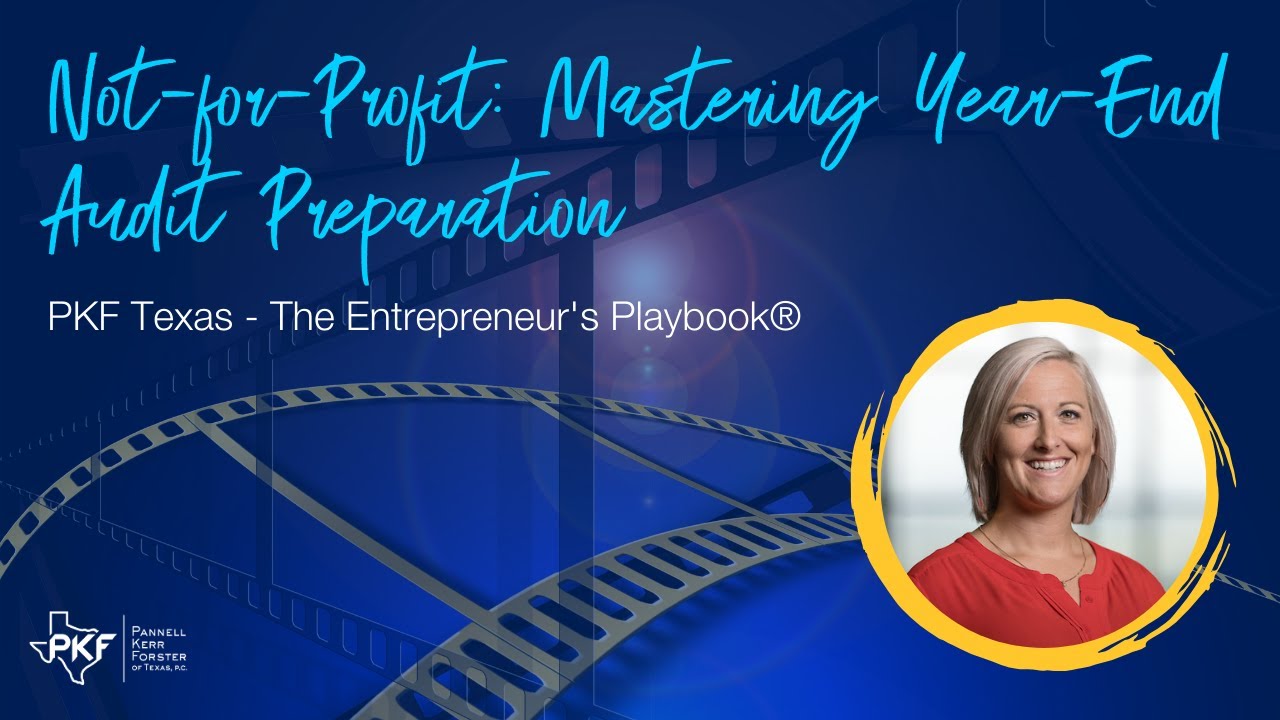Not-for-Profit: Mastering Year-End Audit Preparation

Dive into the essential steps for a successful year-end audit preparation with Nicole Riley, Audit Director and Not-for-Profit Practice Leader at PKF Texas. Learn about achieving a clean balance sheet, handling in-kind donations, and efficiently managing a PBC list. Your audit readiness journey starts here!
Jen: This is the PKF Texas Entrepreneur’s Playbook, I’m Jen Lemanski, and I’m back once again with Nicole Riley, one of our Approachable AdvisorsTM and one of the leaders of our not-for-profit practice here at PKF Texas. Nicole, welcome back to the Playbook.
Nicole: Thanks for having me.
Jen: You’re also on the audit side, not just not-for-profit practice leader, but audit director. And so, what should a not-for-profit organization expect or prepare for the year-end in order to get ready for their audit?
Nicole: The first thing I’ve talked to my clients about is you have to have a good close to start with. And before you even start really thinking about audit prep, get a really good close and it’ll set you up for success. And what I mean by that is having, well, first, all your data entry done, you need to have everything in you need to have really good cutoff. Like year-end is really important to have that cutoff really good, which means talking to development, making sure that if somebody has promised you a gift, that they’ve recorded it as revenue before your end because a lot of times accounting doesn’t know those things and so they don’t know it’s coming until the check arrives. But under the guidance you have to record those promises when the donor promises it to the organization, not when they actually give you the check. And then you need to do the same thing on the expense side you need to go through your accounts payable listing and go, what isn’t there? You know, what do we still owe that we haven’t gotten?
So, once you’ve gotten that cutoff done really well, that’s when you start with your monthly and annual close entries, which is normal. You do it every month, but you need to make sure you do every single account at year-end. You know, make sure your fixed assets, you got all the additions that you bought during the year, all the things that you got rid of that schedule and that listing cleaned up the depreciation recorded as actual, if you were estimating, your prepaids, your accrued vacation. There’s just so much more that a lot of people don’t do during the year that you need to make sure every single balance sheet account is reconciled, closed and done before you even start through the audit prep. Even your in-kind donations, that’s not actually money flowing through your books, but, donors give the organization auction items, they might give food or clothing to the organization. All those items need to be valued, listed, tracked, and recorded in the financial statements at year-end in preparation of getting all those close entries done.
Jen: So, then what should an organization do after they’ve got all that handled?
Nicole: Once you’ve gone through all your balance, done all your closing entries, I recommend them just literally go down their statement of financial position or what a lot of people call the balance sheet account by account, make sure you have the reconciliation completed, you have it ready. Everything in those reconciliations make sense and is current. If there’s anything in those that are just older that may need to be written off, you need to do that now. And then once you’ve gone all the way through your balance sheet or your statement of financial position for nonprofits, you need to look at your statement of activities or what a lot of people call the P&L or the income statement. Look at your fluctuations on that where from budget to actual that those make sense. Look at from year to year. Do those make sense? And a lot of times when you just look at those fluctuations, you might identify where something didn’t get recorded or there was a misclassification. It’s good to clean those up now, to have everything be really clean for the audit. And once you’ve done all of that, you’re really going to be probably 75% ready for your audit preparation.
Jen: So, 75%, there’s another 25% in there. What’s all involved with that other 25%?
Nicole: The auditor should give you what we call a PBC list or a prepared by client list. And that is a huge list depending on how large or complex your organization is, of all the things we want to see before we start the audit. That’s those reconciliation, the bank statements. But there’s a lot of things that we include on there that may not be the accounting department’s responsibility. We ask for the minutes of the finance committee meetings, we ask for the minutes of the board meetings, we want to see any changes to their bylaws, any significant agreements. So, that’s when this next step, last 25% is probably a lot of coordination with others in the organization. Assigning those things to everybody else, giving them due dates and just organizing and gathering that information and uploading it to the auditors. We in-house use a secure software that allows for data to be uploaded securely. It’s called ShareLink. And that software even allows where the client can assign different items to different people within their organization, helps it keep it organized, and gives them a status update.
Jen: They can kind of keep track of things on their end and our end.
Nicole: Yes. And that PBC list is kind of the, I guess the client’s Bible, if that’s everything they need to get ready before we start the audit, just to make the audit process a whole lot smoother because once we get in, we ask for more, we ask for invoices and things, but being prepared and having all that to us really will help the audit preparation. And that’s kind of like what I said, the Bible of getting ready for the audit.
Jen: Nice. Well we’ll get you back to talk about some more things impacting not-for-profit. Sound good?
Nicole: Sounds great.
Jen: This has been another Thought Leader production, brought to you by PKF – Texas the Entrepreneur’s Playbook. For more information about this and other topics, visit pkftexas.com/insights. Tune in next week for another chapter.

